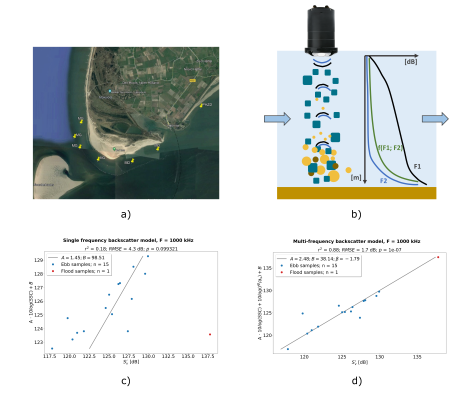R.A.J. Jaarsma1,2*, M. Daugharty1, S.D. Kamminga1, M.A. van der Lugt2,3, M.A. de Schipper2, B.C. van Prooijen2
1 Nortek Netherlands B.V., The Netherlands; 2 Delft University of Technology, The Netherlands; 3 Deltares, The Netherlands
* Corresponding author: ruurd.jaarsma@nortekgroup.com
Introduction
Monitoring of suspended sediment concentration (SSC) is crucial in coastal management: calibration and validation of numerical sediment transport models, turbidity monitoring during dredging activities, and tracking sediment budgets over time are a few related activities. Direct monitoring methods rely on water sampling which are labour intensive and costly. Indirect monitoring methods are based on laser diffraction and optical (OBS) or acoustic (ABS) backscatter measurements. ABS recorded by Acoustic Doppler Current Profilers (ADCP) shows great potential due to the ability of combining with flow measurements, allowing estimates of sediment flux with a single instrument.
As with instruments using OBS, certainty of ADCP SSC predictions depends on the use of appropriate relations between backscatter and SSC. The theoretical relation between SSC and backscatter is sensitive to sediment properties such as particle size. Therefore, frequent checks of sediment properties in the water column are necessary, which often involves extensive water sampling (Plancke et al. 2017). There are methods to reduce the sensitivity of the appropriate relation between backscatter and SSC, based on multi-frequency backscatter response. Although showing promising potential, up until now their application has been limited by alignment issues induced by using separate instruments (Guerrero et al., 2013; Jourdin et al., 2014).
Objective and Methods
To overcome these alignment limitations, a Nortek Signature1000 ADCP was adapted to record near simultaneous, multi-frequency backscatter profiles using its high-resolution, vertical echosounder transducer. Whether certainty in ADCP SSC predictions can be increased using this instrument was assessed based on a field campaign in the Molengat tidal channel near Texel Island, The Netherlands (Figure 1a) in Spring 2022. Using a small boat, backscatter was recorded at 1000, 500 and 250 kHz under varying flow conditions while simultaneously acquiring water samples using a Niskin bottle sampler. The multi-frequency processing method – where estimates of mean particle radius are derived based on particle size-acoustic wavelength interactions (Thorne & Meral, 2008) – was applied based on the 1000 and 500 kHz signal and after including these particle radius estimates in an adapted backscatter-SSC relation, compared with the more traditional single frequency approach.
Results
Based on correlations of the SSC deduced from backscatter and Niskin bottle sampled SSC, performance of the single frequency approach was found to be reasonable for measurements taken during a single ebb tidal phase. Applying this traditional ADCP backscatter method to a combined set of ebb and flood measurements led to poor results due to strong variations in observed backscatter intensity (Figure 1c), presumably induced by variations in particle properties over the tidal cycle. In the multi-frequency approach, correlations improved significantly, and ebb and flood measurement samples were both predicted well (Figure 1d).
Follow-up work should include an analysis of the water sample’s particle diameter to confidently attribute the improved performance of the multi-frequency method to changing particle properties and should assess a larger sample size. This application of the multi-frequency approach using the vertical echosounder transducer on the Nortek Signature1000 ADCP shows the potential for improved SSC estimates from sailing ADCP monitoring. Combined with profiles of current velocity and direction, there is the ability to monitor suspended sediment fluxes all in one single instrument.

Figure 1: a) Field measurements were taken in and around the Molengat tidal channel near Texel Island in Spring 2022. b) Based on particle size-acoustic wavelength interactions, the backscatter response varies with particle size between frequencies. Combining empirical backscatter responses with multi-frequency measurements yields mean particle radius estimates, which can be applied to establish a more robust relation between backscatter and SSC. c), d) Performance differences of the single and multi-frequency approach for a combined ebb and flood measurement set.
References
Guerrero, M., Szupiany, R. N., & Latosinski, F. (2013). Multi-frequency acoustics for suspended sediment studies: An application in the Parana River. Journal of Hydraulic Research, 51(6), 696–707. https://doi.org/10.1080/00221686.2013.849296
Jaarsma, R. A. J. (2023). Quantifying suspended sediment using multi-frequency echosounder measurements [Delft University of Technology]. https://repository.tudelft.nl/islandora/object/uuid%3A82cfb0e6-863a-4f85-a8bc-7c5e16c69b05
Jourdin, F., Tessier, C., Le Hir, P., Verney, R., Lunven, M., Loyer, S., Lusven, A., Filipot, J.-F., & Lepesqueur, J. (2014). Dual-frequency ADCPs measuring turbidity. Geo-Marine Letters. https://doi.org/10.1007/s00367-014-0366-2
Plancke, Y. M. G., Vandebroek, E., Claeys, S., & Meire, D. (2017). Sediment transport in the Schelde-estuary: The challenge of performing good measurements in challenging conditions. Hydraulic Measurements and Experimental Methods 2017 Conference (HMEM 2017.
Thorne, P. D., & Meral, R. (2008). Formulations for the scattering properties of suspended sandy sediments for use in the application of acoustics to sediment transport processes. Continental Shelf Research, 28(2), 309–317. https://doi.org/10.1016/j.csr.2007.08.002


